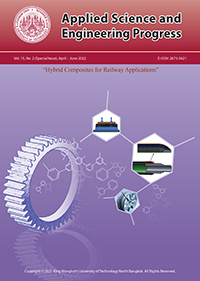Application of Bumpers in Different Types of Railway Vehicles: A Short Review
Main Article Content
Abstract
In order to avoid traffic problems in developed countries, railway vehicles play an important role. Passengers, railway workers, goods, cargo utilization, and dangerous materials are being transferred using various railway vehicles, and each vehicle is designed for a specific manner. Such vehicles include different locomotives that work on either electric or diesel power, in addition to different wagons and carriages attached to these locomotives (passenger wagons, sleeping wagons, freight wagons, and several other types, etc.). Railway vehicles run on railroad tracks, these tracks are designed and maintained by specific machines (diagnostic machines, road renewal machines, ballast screening, tamping and regulating machines, etc.). Several methods are applied when coupling wagons or carriages to each other (automatic coupling, semi-automatic traction, and hook clutch drawbar) depending on vehicle type and function. Railroad vehicles are considered a safe transportation system compared to other systems because they use buffers and bumpers to ensure safety. This paper mounts a minor review of railway vehicles, machines used to make railroads, coupling systems, bumpers and, buffers used to ensure railway vehicle’s safety, and also focuses on the previous studies conducted to enhance such bumpers and lessen collision effects.
Article Details
References
R. A. MacNeill, S. W. Kirkpatrick, R. T. Bocchieri, and G. Gough, “Development of a prototype retrofit bumper for improved Light Rail Vehicle safety,” in Joint Rail Conference, 2015, pp. 1–8, doi: 10.1115/JRC2015-5810.
W. Johnson and A. G. Mamalis, Crashworthiness of Vehicles. England: Mechanical Engineering Publications, 1978.
E. Andersson, M. Berg, S. Stichel, and C. Casanueva, Rail Systems and Rail Vehicles: Part 2: Rail Vehicles. Stockholm, Sweden: KTH Royal Institute of Technology, 2016.
B. Szaksz and G. Stepan, “Stability charts of a delayed model of vehicle towing,” IFAC-Papers OnLine, vol. 54, no. 18, pp. 64–69, 2021, doi: 10.1016/j.ifacol.2021.11.117.
F. J. G. Haut, Electric Locomotives of the World. UK: Bradford Barton, 1977.
M. Cipek, D. Pavković, M. Krznar, Z. Kljaić, and T. J. Mlinarić, “Comparative analysis of conventional diesel-electric and hypothetical battery-electric heavy haul locomotive operation in terms of fuel savings and emissions reduction potentials,” Energy, vol. 232, 2021, Art. no. 121097, doi: 10.1016/j.energy.2021.121097.
Y. H. Chang, C. H. Yeh, and C. C. Shen, “A multiobjective model for passenger train services planning: Application to Taiwan’s high-speed rail line,” Transportation Research Part B: Methodological, vol. 34, no. 2, pp. 91–106, 2000, doi: 10.1016/S0191-2615(99)00013-2.
A. Rodríguez, R. Sañudo, M. Miranda, A. Gómez, and J. Benavente, “Smartphones and tablets applications in railways, ride comfort and track quality. Transition zones analysis,” Measurement, vol. 182, 2021, Art. no. 109644, doi: 10.1016/j.measurement.2021.109644.
S. Coxon, K. Burns, and A. D. Bono, “Design strategies for mitigating passenger door holding behavior on suburban trains in Paris,” in 33rd Australasian Transport Research Forum Conference, 2010, pp. 1–15.
M. Paczek, A. Wróbel, and A. Buchacz, “A concept of technology for freight wagons modernization,” IOP Conference Series: Materials Science and Engineering, vol. 161, no. 1, 2016, doi: 10.1088/1757-899X/161/1/012107.
Q. Li, Z. Shi, H. Zhang, Y. Tan, S. Ren, P. Dai, and W. Li, “A cyber-enabled visual inspection system for rail corrugation,” Future Generation Computer Systems, vol. 79, pp. 374–382, 2018, doi: 10.1016/j.future.2017.04.032.
R. Mohammadi, Q. He, and M. Karwan, “Data driven robust strategies for joint optimization of rail renewal and maintenance planning,” Omega, vol. 103, 2021, Art. no. 102379, doi: 10.1016/ j.omega.2020.102379.
X. Xiao, D. Cai, L. Lou, Y. Shi, and F. Xiao, “Application of asphalt based materials in railway systems: A review,” Construction and Building Materials, vol. 304, 2021, Art. no. 124630, doi: 10.1016/j.conbuildmat.2021.124630.
L. Li, D. Thompson, Y. Xie, Q. Zhu, Y. Luo, and Z. Lei, “Influence of rail fastener stiffness on railway vehicle interior noise,” Applied Acoustics, vol. 145, pp. 69–81, 2019, doi: 10.1016/j.apacoust. 2018.09.006.
T. Ouyang, G. Huang, S. Li, J. Chen, and N. Chen, “Dynamic modelling and optimal design of a clutch actuator for heavy-duty automatic transmission considering flow force,” Mechanism and Machine Theory, vol. 145, 2020, Art. no. 103716, doi: 10.1016/j.mechmachtheory.2019.103716.
B. E. Paden, P. M. Kelly, J. A. Hines, D. Bothman, and C. Simms, “On the feasibility of life-saving locomotive bumpers,” Accident Analysis and Prevention, vol. 89, pp. 103–110, 2016, doi: 10.1016/j.aap.2015.12.025.
P. Xu, C. Qu, S. Yao, C. Yang, and A. Wang, “Numerical optimization for the impact performance of a rubber ring buffer of a train coupler,” Machines, vol. 9, no. 10, 2021, doi: 10.3390/ machines9100225.
S. Pirmohammad, “Collapse study of a pair thinwalled prismatic column subjected to oblique loads,” International Journal of Automotive Engineering, vol. 1, no. 4, pp. 267–279, 2011.
M. Pyrz and M. Krzywoblocki, “Crashworthiness optimization of front rail structure using macro element method and evolutionary algorithm,” Structural and Multidisciplinary Optimization, vol. 60, no. 2, pp. 711–726, 2019, doi: 10.1007/ s00158-019-02233-7.
Ø. Jensen, M. Langseth, and O. S. Hopperstad, “Experimental investigations on the behaviour of short to long square aluminium tubes subjected to axial loading,” International Journal of Impact Engineering, vol. 30, no. 8–9, pp. 973–1003, 2004, doi: 10.1016/j.ijimpeng.2004.05.002.
A. Haidari and P. H. Tehrani, “Crack driving force calculation for a railway wheel considering thermoplastic properties of the wheel material TT,” IJRARE, vol. 7, no. 1, pp. 29–39, Jun. 2020, doi: 10.22068/IJRARE.7.1.29.
S. R. Reid, “Plastic deformation mechanisms in axially compressed metal tubes used as impact energy absorbers,” International Journal of Mechanical Sciences, vol. 35, no. 12, pp. 1035– 1052, 1993, doi: 10.1016/0020-7403(93)90054-X.
W. Abramowicz and N. Jones, “Dynamic axial crushing of circular tubes,” International Journal of Impact Engineering, vol. 2, no. 3, pp. 263–281, 1984, doi: 10.1016/0734-743X(84)90010-1.
G. Gao, W. Guan, J. Li, H. Dong, X. Zou, and W. Chen, “Experimental investigation of an active–passive integration energy absorber for railway vehicles,” Thin-Walled Structures, vol. 117, pp. 89–97, 2017, doi: 10.1016/j.tws. 2017.03.029.


